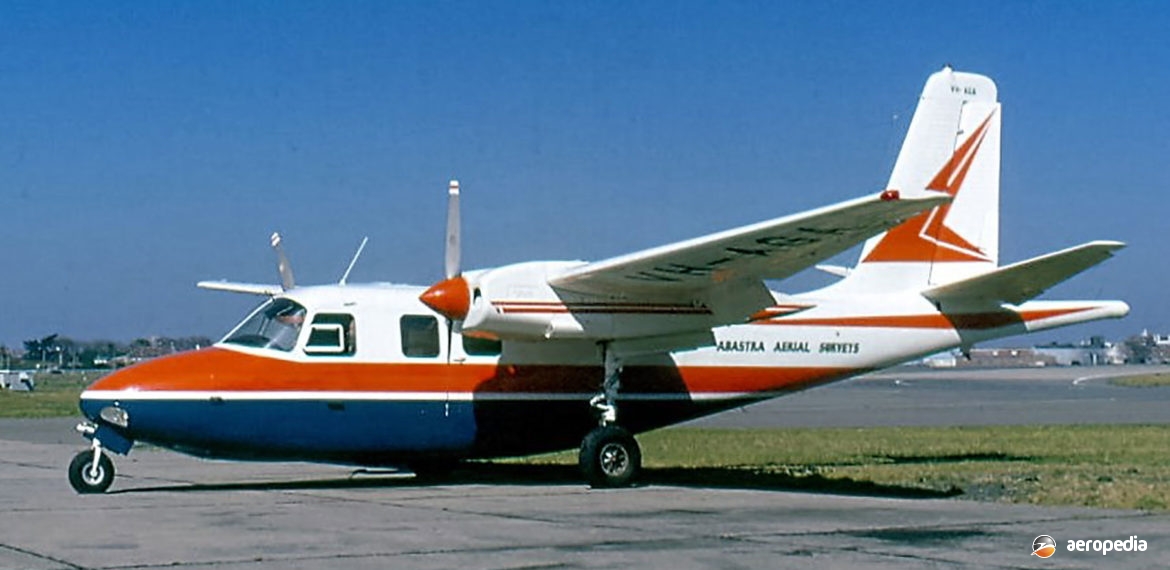Photograph:
Aero Commander 500A VH-AGA (c/n 500A-1253-77) of Adastra Aerial Surveys at Mascot, NSW in September 1972 (David C Eyre)
Country of origin:
United States of America
Description:
Light business and executive transport
Power Plant:
Two 216 kw (290 hp) Lycoming IO-540-E1B5 six-cylinder horizontally-opposed air-cooled engines
Specifications:
- Wingspan: 14.95 m (49 ft 0½ in)
- Length: 11.15 m (36 ft 7 in)
- Height: 4.42 m (14 ft 6 in)
- Wing area: 23.69 m² (255 sq ft)
- Max speed at sea level: 346 km/h (215 mph)
- Cruising speed at 75% power at 2,745 m (9,000 ft): 326 km/h (203 mph)
- Stalling speed flaps down: 109 km/h (68 mph)
- Service ceiling: 5,913 m (19,400 ft)
- Range with standard fuel at 2,745 m (9,000 ft) at 330 km/h (205 mph): 1,207 km (750 miles)
- Max range at 45% power at 4,570 m (15,000 ft) at 274 km/h (170 mph) with no reserves: 1,735 km (1,078 miles)
- Empty weight: 2,050 kg (4,520 lb)
- Loaded weight: 3,062 kg (6,750 lb)
History:
Aero Design and Engineering Company, which was formed in December 1944 in Culver City, California, by two former Douglas Aircraft Co employees, produced an aircraft known as the Aero Commander L-3805. This machine, designed by Ted Smith, flew for the first time on 23 April 1948. Three prototypes were built and it entered production as the Commander 520 six-seven seat light transport powered by two 179 kw (240 hp) Lycoming GO-435-C2 engines. 150 were built and it was succeeded in production by the Model 560 in 1954. Three Model 520s were evaluated by the US Army as the YL-26, the designation later being changed to YU-9A. One U-4B was used as a Presidential Transport by Dwight Eisenhower between 1956 and 1960.
In 1958 the Model 500 appeared. This was a structurally similar but lower-powered variant of the basic Aero Commander 560. Seating up to six persons, it was produced in two versions: the 500A with two 194 kw (260 hp) Continental IO-470-M engines; and the 500B with two 216 kw (290 hp) Lycoming IO-540-B1A engines. Deliveries of the latter model commenced in July 1960. In 1958 Aero Commander Inc, which had been producing the series of aircraft in a facility in Oklahoma since 1950, after changing its name, became part of Rockwell-Standard Corporation.
In 1967 the Company merged with North American. In 1973 the series became part of the Rockwell International stable as a result of further mergers. Between 1968 and 1976 the Company produced 316 Shrike Commanders. The Shrike Commander was still in operation with the US Coast Guard and the United States Customs Service in 2004.
Eventually this series became known as the Model 500U, seating four persons, two in front with dual controls and two at the rear. However, a wide range of options permitted the carriage of up to eight persons. This model was superseded by the 500S, which was given the name Shrike Commander. The latter was the most profuse of all Aero Commander models sold in Australia where it was used for charter and executive work; as an aerial ambulance in Victoria; and on commuter airline work by Kendell Airlines, Tasman Air, MacKnight Airlines and others. Examples have been registered in both Australia and New Zealand.
Legendary pilot R A “Bob” Hoover for 30 years flew a Shrike Commander (N500RA), a stock aircraft. A former fighter ace in World War II and Korea, and test pilot, he commenced demonstrating the Shrike in 1973 and displayed demonstrations of high and low-speed handling capabilities, as well as its capabilities with one engine and no engine. He flew 16 point rolls and loops, a precise dead-stick manoeuvre with a loop, eight-point roll, a 180 degree turn to a touchdown with first one wheel and then the other wheel, landing and taxiing in front of the crowd with the engines stopped. This display was widely seen throughout the United States and on a number of occasions at aviation events in Australia.

